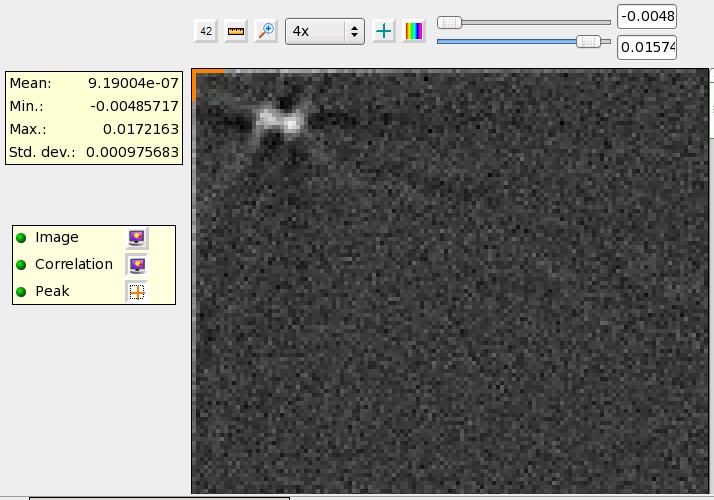Difficulty in beam-tilt based autofocus at high magnification
Added by Anchi Cheng over 14 years ago
e-mail from ncoudray;
I'm contacting you because we have some problems obtaining a correct focus at High Magnification (x120k). At first, I noticed that often, the correlation peak was not properly detected (sometimes, it was just one isolated pixel on the correlation image which had a higher value than the peak we would choose visually... I joined an image as an example, where one pixel at the corner of the image is chosen)... I added a smoothing filter before the detection. In our case, it looks like it helped for the detection of the correlation peak, but the focus set is still not good...
In some cases, even though the correlation peak seems properly detected, the focus set is far from the expected one (for instance, on recent acquisitions the defocus was as far as +30 um at 120k)...
As you suggested in http://emg.nysbc.org/projects/leginon/wiki/Optimizing_Autofocus, we first do a Z-Focus (stage tilt at 2.5k in our case)... Do you know if the autofocus method may indeed be inefficient on some cases, or if it is more likely that some configuration is not properly done for our jeol1230?

Replies (2)
RE: Difficulty in beam-tilt based autofocus at high magnification - Added by Anchi Cheng over 14 years ago
Beam-tilt based focus measurement is based on the coma effect created by tilting the beam. It does have limits. You can learn the details in Typke and Dierksen (1995) Optik 99:155-166. To summary it, the aberration that gives images shift for a defocused image under different beam tilts also gives apparent defocus and astigmatism change. As a result, the two images that are correlated in this measurement are not related only by a translation, and hence the double peak you see in your correlation image. There is a similar type of distortion in the correlation image shown in [Optimizing_Autofocus]
At high magnification (or ,to use a better term, smaller pixel size), the additional aberration is more obvious because the details of the image are more resolved. The split of the real peak does make peak detection harder, so I am not surprise of your problem. It would have been true on any microscope. However, I can also see streak at x=0 and y=0 in your correlation map which may be related to the filtering function you added since I've never seen that before. The double-channel gain correction used in Leginon usually take care of the origin peak. You may want to check your gain corrections in this case.
As for the defocus measurement been off by 30 um, even when the correct peak was found, you should check if the defocus calibration done in Beam_Tilt node is reasonable at this mag. During the calibration, two defocii are used so you should see the correlation peak position change between them. For example, if you are well focused to start with and use 2e-6 m and 4e-6 m for the two defocii, the correlation peak distance to the origin should roughly double. If both are so close to the origin so that a difference can not be tell, the calibration won't be usable. In such a case, the measured image shift would be transformed into defocus incorrectly.
Another point is that you did the Z-focus at 2.5 kx, which is 50 times smaller in magnification which might not be good enough to bring the defocus variation within the limit of linearity for a measurement at 120 kx. If you need to do the focus at such a high magnification, you might want to add an intermediate mag for a medium defocus or z-height correction to bridge the gap.
Regarding possible JEOL1230-specific configuration problem, the only thing I can say is that you should check it yourself. We wrote pyscope assuming the returning value from tem subclass is in SI unit. Whether JEOL-1230.py and JEOL-1230lib.py written by Minghui makes the conversion from JEOL-1230 readout to SI unit or not is not what I can tell from the reading the code alone.
RE: Difficulty in beam-tilt based autofocus at high magnification - Added by Nicolas Coudray over 14 years ago
Hello,
Thank you for your reply.
Just a small correction: the correlation image was acquired before the added filtering step, so the streaks at x and y=0 come from somewhere else (I also forgot to mention that the "false peaks" detected were not only located at the edges of the image... this example is just a particular case... sorry for the imprecisions).
Anyway, as suggested, I'll check the gain correction and the Beam_Tilt calibration. We have already tried to reduce the gap between the magnifications at which the eucentric height is measured and the one at which the focusing is done (to 5k and 50k)... but were not yet successful. We'll however carry on to explore this solution.
Again, thanks a lot,
Best
N.C.